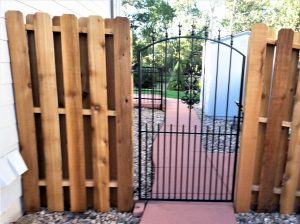All Categories
Featured
When it involves maintaining a wooden fence, house owners usually face the decision of whether to paint or stain. Both options have their cons and pros, and the option ultimately relies on your visual preferences, the kind of timber, and just how much upkeep you want to commit to. Here's an in-depth contrast to assist you make a notified choice.
The Basics of Painting and Staining
Painting includes covering the wood with a nontransparent layer of shade. It supplies total protection, hiding the wood grain while using outstanding defense versus ecological components.
Discoloring penetrates the wood, enhancing its natural elegance while including a safety layer. Relying on the kind, stains can vary from clear to strong, allowing differing degrees of timber grain exposure.
Pros and Cons of Painting
Pros:
Variety of Color styles: Repaint offers countless shade alternatives, allowing you to match your fence to your home's outside or personal style.
Longer Long-term: Premium exterior paint can last as much as 5-7 years, calling for much less frequent reapplication.
Superior Security: Paint types a thick, strong barrier versus wetness, UV rays, and parasites.
Disadvantages:
Cracking and peeling off: In time, paint can peel or fracture, especially in locations with extreme climate conditions.
Hides Natural Wood Charm: If you enjoy the natural grain of timber, paint might not be the most effective choice.
Greater Upkeep: Repainting needs scraping off the old paint, which can be labor-intensive.
![]()
Pros and Disadvantages of Staining
Pros:
All-natural Appearance: Stains protect and enhance the all-natural appeal of the wood, making it ideal for top notch lumber like cedar or redwood.
Less Complicated to Reapply: Unlike paint, discolorations don't peel off or fracture. Reapplying tarnish commonly needs less surface area prep work.
Versatile Finish Alternatives: Discolorations been available in clear, semi-transparent, and solid varieties, using different levels of coverage.
Disadvantages:
![]()
Much Shorter Life-span: Spots, semi-transparent and particularly clear ones, may require reapplication every 2-3 years.
Restricted Color Options: While spots provide natural tones, they do not have the broad shade combination offered with paint.
Less Protective: Stains pass through the wood however don't provide as thick an obstacle as paint, making them somewhat much less safety versus severe weather condition.
Elements to Take Into Consideration
Aesthetic Preferences: If you desire lively shades and full coverage, paint is the method to go. For a all-natural and rustic appearance, opt for discolor.
Wood Type: Premium timbers with stunning grains take advantage of discoloration, while lower-grade timbers can be painted for a sleek appearance.
![]()
Climate: In humid or damp climates, paint's thicker obstacle might provide far better security. In moderate or dry climates, stains can suffice.
Upkeep Dedication: Paint entails less frequent reapplication but even more effort throughout touch-ups. Discoloration calls for normal upkeep yet is less complicated to handle.
Final Thoughts
Both paint and discoloration can successfully shield and beautify your wooden fencing. The most effective choice depends on your concerns, whether they lean towards visual appeals, durability, or convenience of upkeep. By recognizing the benefits and downsides of each, you can choose the coating that aligns with your demands and guarantees your fencing stays a standout feature of your property for several years ahead.
The Basics of Painting and Staining
Painting includes covering the wood with a nontransparent layer of shade. It supplies total protection, hiding the wood grain while using outstanding defense versus ecological components.
Discoloring penetrates the wood, enhancing its natural elegance while including a safety layer. Relying on the kind, stains can vary from clear to strong, allowing differing degrees of timber grain exposure.
Pros and Cons of Painting
Pros:
Variety of Color styles: Repaint offers countless shade alternatives, allowing you to match your fence to your home's outside or personal style.
Longer Long-term: Premium exterior paint can last as much as 5-7 years, calling for much less frequent reapplication.
Superior Security: Paint types a thick, strong barrier versus wetness, UV rays, and parasites.
Disadvantages:
Cracking and peeling off: In time, paint can peel or fracture, especially in locations with extreme climate conditions.
Hides Natural Wood Charm: If you enjoy the natural grain of timber, paint might not be the most effective choice.
Greater Upkeep: Repainting needs scraping off the old paint, which can be labor-intensive.

Pros and Disadvantages of Staining
Pros:
All-natural Appearance: Stains protect and enhance the all-natural appeal of the wood, making it ideal for top notch lumber like cedar or redwood.
Less Complicated to Reapply: Unlike paint, discolorations don't peel off or fracture. Reapplying tarnish commonly needs less surface area prep work.
Versatile Finish Alternatives: Discolorations been available in clear, semi-transparent, and solid varieties, using different levels of coverage.
Disadvantages:

Much Shorter Life-span: Spots, semi-transparent and particularly clear ones, may require reapplication every 2-3 years.
Restricted Color Options: While spots provide natural tones, they do not have the broad shade combination offered with paint.
Less Protective: Stains pass through the wood however don't provide as thick an obstacle as paint, making them somewhat much less safety versus severe weather condition.
Elements to Take Into Consideration
Aesthetic Preferences: If you desire lively shades and full coverage, paint is the method to go. For a all-natural and rustic appearance, opt for discolor.
Wood Type: Premium timbers with stunning grains take advantage of discoloration, while lower-grade timbers can be painted for a sleek appearance.

Climate: In humid or damp climates, paint's thicker obstacle might provide far better security. In moderate or dry climates, stains can suffice.
Upkeep Dedication: Paint entails less frequent reapplication but even more effort throughout touch-ups. Discoloration calls for normal upkeep yet is less complicated to handle.
Final Thoughts
Both paint and discoloration can successfully shield and beautify your wooden fencing. The most effective choice depends on your concerns, whether they lean towards visual appeals, durability, or convenience of upkeep. By recognizing the benefits and downsides of each, you can choose the coating that aligns with your demands and guarantees your fencing stays a standout feature of your property for several years ahead.
Latest Posts
Transform Your Home with Expert Flooring Solutions
Published Jan 14, 25
2 min read
Modern Customized Gates
Published Jan 14, 25
0 min read
Discoloring vs. Repainting Your Wood Fence: Which Is Much better?
Published Jan 14, 25
0 min read